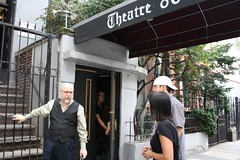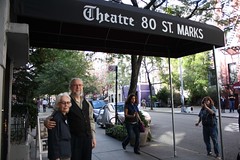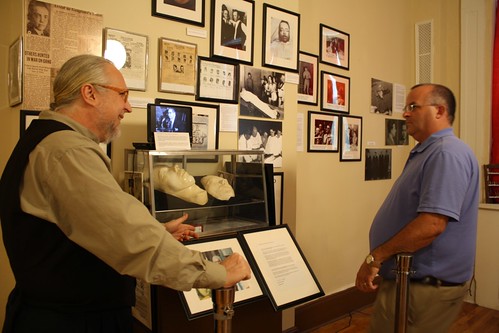 Maya Millett Lorcan Otway guides a tour of prohibition enthusiasts towards the gangster museum, located on the upper level of Theater 80.
Maya Millett Lorcan Otway guides a tour of prohibition enthusiasts towards the gangster museum, located on the upper level of Theater 80.Long before the Beat poets, the Warhol kids, free-spirited artists and musicians came to define the East Village’s bohemian scene, a different kind of character dominated the streets: the neighborhood bootlegger.
During the height of the 1920s Prohibition era, New York City served as the American gangster’s playground. Behind ordinary storefronts and in dingy back alleyways, men and women thirsty for forbidden libations and the prospect of a good time crept up to nondescript doors and slipped into another world. At the height of the Jazz Age, America was ready to dabble in debauchery even in the East Village, where European immigrant families crowded into tenement buildings.
Unlike the glamorous settings depicted on the new HBO series “Boardwalk Empire” the face of the speakeasy owner here was often not a wily gangster, but a German shopkeeper or a Jewish teacher. For these East Villagers, starting a speakeasy was as easy as opening their homes for an afternoon to sell alcohol. The illegal booze was snagged through a number of enterprising means — whether through dealings with a local bootlegger or grabbing what they could from a stalled truck transporting the stuff. “It was just kind of a buyer’s market — bootleggers were slipping menus underneath doors like Chinese food menus.”
So says Michael Lerner, author of “Dry Manhattan: Prohibition in New York City.” Mr. Lerner sketches a more low-key picture of the East Village, with its many speakeasies reflections of the working-class immigrant communities: “These were people who were looking to make a little extra money, to pay the rent, and maintain a little normalcy of what it was like pre-Prohibition.”
The scope of the criminal activity documented in police reports of the time mostly involved “Jews and wine and synagogues,” Mr. Lerner says. Police caught men posing as “rabbis” hoarding sacramental wine (which was legal during Prohibition), and confiscated barrels of beer, a popular choice among the large German community in the East Village. “New York was a working class city, and had a lot of working class neighborhoods. People were coming from cultures where alcohol was just part of their lives,” Mr. Lerner says.
Though Mr. Lerner found that most East Village speakeasies were hidden in apartment houses, the neighborhood did have at least one fancy watering hole. To experience a little of the glitzy side of Prohibition, take a stroll to St. Marks Place.
Lorcan Otway, the owner of Theater 80 at 80 St. Marks, opened a museum exclusively devoted to the American gangster in March. The Otway family has lived in the East Village for years, and the history of the theater is somewhat of a community legend. Mr. Otway’s father, Howard, bought the building in 1964 from one Walter Scheib, a well-known rumrunner and gangster who ran a successful speakeasy in the space.
Mr. Otway, 55, guides guests through the theater’s bar and low-ceilinged basement, home to a 1920s liquor locker — ancient, fading beer bottle labels still plastered on the walls by long-gone waiters. The basement also features an old radiator that would have acted as a detonation device when smashed, blowing up the building — and everyone inside — in the event of a police raid.
And while Mr. Otway has gathered an impressive collection of historical memorabilia one might typically associate with the gangster scene at the time — bullets from the infamous St. Valentine’s Day massacre, death masks of the slain Chicago gangster John Dillinger — the owner also showcases the lesser-known side of that storied 1920s era.
“You’ll notice that we’re trying to get away from a lot of the stereotypes people have about organized crime,” Mr. Otway says.
Check out portrait artist Pat Hamou’s exhibit on the Jewish men who influenced New York’s organized crime scene, “Six for Five — Portraits and Profiles of New York City’s Jewish Criminal Community 1900-1945” currently on display at the museum.
Though the East Village may have taken a backseat to the wild and crazy juice joints that once populated Midtown, the West Village and Harlem, the neighborhood is certainly making up for it now. Pop in to one of the neighborhood’s modern-day speakeasies that have been discreetly cropping up lately, including the swanky PDT bar (Please Don’t Tell; 113 St. Marks Place), the rum-centric Cienfuegos (443 E. Sixth Street), and one of the neighborhood’s most recent additions, the Blind Barber (339 E. 10th Street).
Other famous East Village Prohibition haunts still around today:
John’s of 12th Street, 302 E. 12th Street, between First and Second Avenues. This classic Italian eatery built in 1908 was a clandestine mom-and-pop speakeasy during Prohibition days. The restaurant changed hands in the 1970s, but the original family satisfied more than customers’ hunger by serving up homemade hooch brewed in the restaurant’s backyard.
KGB Bar, 85 E. Fourth Street, between Bowery and Second Avenue. Though the literary enclave has its own colorful history, the bar was built during the Prohibition era by Five Families originator Charles “Lucky” Luciano. During the mob boss’s reign, the space was known as the Palm Casino.





